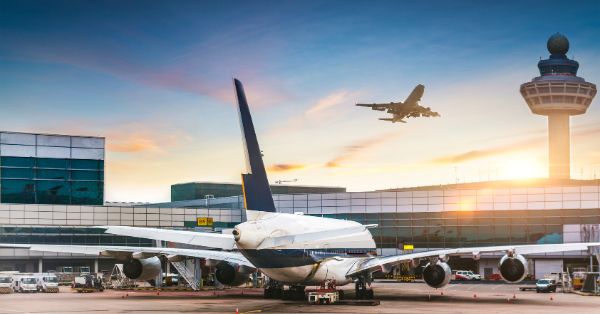With an estimated 4.7 billion people expected to access airports this year, the aviation sector remains one of the world’s most critical enablers of global mobility and economic growth. But what keeps these ‘cities in motion’ operating safely, securely, and efficiently? The answer increasingly lies in robust, pervasive private connectivity networks that power every layer of airport operations and air travel.
Airports as Smart Cities in the Sky
Modern airports have evolved far beyond their original purpose as mere points of departure and arrival. They are now bustling economic engines that support thousands of jobs, connect millions of passengers and cargo shipments daily, and drive billions in local and national GDP. From retail concessions and multi-level parking garages to baggage systems, ground transport hubs, and even on-site hotels and conference centers, airports operate like self-contained cities.
Their complexity demands advanced coordination. Landside operations must manage huge volumes of vehicle traffic, rideshare pick-ups, parking management, and curbside drop-offs. Within terminals, every passenger touchpoint, from check-in and bag drop to biometric screening and boarding, is being digitized to reduce queues and stress. Meanwhile, airfield operations require absolute precision, with ground crews, pilots, and air traffic controllers working in tight harmony to keep flights on schedule. Any breakdown in connectivity can cascade into costly delays, lost revenue, and passenger dissatisfaction.
This is why treating airports like smart cities—with a backbone of integrated, reliable connectivity—has become a cornerstone of modernization plans worldwide.
Why Connected Aviation is Non-Negotiable
Connectivity isn’t just a ‘nice-to-have’ in today’s airports; it’s the hidden infrastructure that makes the modern aviation experience possible. The volume of real-time data flowing between thousands of people, systems, and machines is staggering. A single flight’s turnaround requires coordination between pilots, air traffic controllers, baggage handlers, catering services, refueling crews, and maintenance teams—all exchanging data continuously.
Safety and security are equally dependent on connectivity. Sophisticated surveillance systems monitor passengers, cargo, and restricted areas. Perimeter fences are equipped with smart sensors to detect breaches. Drones perform runway inspections that used to take hours on foot. Critical systems like emergency response coordination, fire suppression, and weather monitoring all rely on stable data networks.
For passengers, expectations have changed dramatically. Travelers expect frictionless, touchless journeys, digital boarding passes, automated gates, real-time flight updates, and instant rebooking during disruptions. Meanwhile, airlines and concessionaires see connected aviation as a path to new revenue streams through personalized retail, loyalty programs, and tailored travel experiences.
Without robust and secure connectivity, these innovations simply cannot scale reliably or safely.
The Backbone of Smart Airports: Private Wireless Networks
Public Wi-Fi and carrier-based cellular coverage serve a purpose for general passenger needs but fall short when it comes to mission-critical operations. Airports require dedicated networks with guaranteed bandwidth, tailored performance, and heightened security to support a growing array of use cases that simply cannot tolerate congestion or downtime.
Private wireless networks, especially private LTE and 5G, solve this challenge by creating a secure digital layer that airports fully control. They can dedicate slices of spectrum for specific use cases, such as autonomous baggage vehicles, airfield robotics, or AR headsets for maintenance crews. This segregation prevents interference and ensures that life-safety or high-priority tasks always get the bandwidth they need.
Another key benefit is data sovereignty. Sensitive operational data, such as security feeds or aircraft telemetry, stays on-premises rather than traveling through a public network or third-party data center, dramatically reducing cyber risks.
Private 5G also provides the ultra-low latency and massive device density required for next-gen applications, such as swarm drone inspections, connected emergency vehicles, and digital twins that model entire airport operations in real-time. As airports scale up digital initiatives, private networks give them a runway to experiment, iterate, and expand securely.
Connected Aviation Use Cases: Smart Airports in Action
The real power of connected aviation comes alive in how private networks unlock new capabilities in different airport zones:
- Airside Automation: Ground support operations are some of the most resource-intensive and time-critical activities at any airport. Autonomous baggage carts, driverless pushback tugs, and connected fuel trucks reduce delays and minimize human error. These machines rely on continuous, ultra-reliable wireless links to operate safely among people, aircraft, and other equipment. With private networks, airports can orchestrate dozens of automated vehicles simultaneously, reducing turnaround times and lowering operational costs.
- Smart Security and Safety: Traditional security cameras are giving way to intelligent surveillance systems that use AI to detect suspicious behavior in real time. Perimeter drones patrol fence lines and runways, performing inspections faster than ground crews ever could. These drones need resilient, low-latency connections to relay high-resolution video and telemetry to control centers without interruption—something private 5G excels at delivering.
- Terminal Digitization: Inside terminals, private networks enable seamless passenger flows through biometric gates, dynamic signage that responds to crowds, and personalized retail offers pushed to passengers’ devices. During irregular operations—like severe weather—connected systems can reroute passengers, adjust staffing, and push instant updates to keep chaos at bay.
- Connected Workforce: Maintenance crews equipped with AR headsets can receive remote support from specialists thousands of miles away, while technicians performing aircraft inspections stream live video over secure connections. Baggage handlers and ramp crews use ruggedized devices to update job statuses instantly, helping operations teams make real-time decisions.
Driving Revenue and Sustainability with Connected Airports
Investing in private wireless networks doesn’t just optimize day-to-day operations—it opens doors to broader business transformation. For many airports, non-aeronautical revenue (from retail, parking, and services) accounts for a large share of profit. Better data insights help airports refine layouts, guide passengers toward concessions, and personalize promotions based on dwell time and demographics.
From a sustainability perspective, connected IoT systems enable smarter resource management. Sensors track energy use, adjust HVAC based on occupancy, and optimize lighting. Electric ground vehicles and autonomous tugs communicate with charging stations and dispatch systems, creating efficiencies that reduce carbon emissions and operating costs.
Airports can also extend secure private network capabilities to airline partners, logistics providers, and freight handlers. By creating a connected ecosystem, they generate opportunities for shared services, new monetization models, and stronger partnerships with stakeholders who need the same resilient connectivity for their operations.
How Airports Can Build a Future-Proof Connectivity Roadmap
Rolling out a private wireless network in an active, complex airport environment isn’t plug-and-play. Success starts with a clear roadmap and strong collaboration among stakeholders—airport authorities, regulators, airlines, technology providers, and security teams must align on goals, compliance requirements, and execution timelines.
Spectrum strategy is critical. Airports need to secure licensed or shared spectrum for private LTE/5G that supports mission-critical reliability without interference. Legacy systems—like radio networks used by ground crews—often need to be integrated or replaced with new devices capable of leveraging the private network.
Cybersecurity can’t be an afterthought. As airports digitize more systems, they must design robust frameworks to protect data, segment networks, and maintain compliance with aviation-specific standards and national security mandates.
Future-proofing is equally important. Today’s rollout must be able to evolve to handle emerging trends like urban air mobility, advanced air traffic management, and AI-powered airport digital twins. The right connectivity roadmap positions airports not just to keep up with demand, but to lead the next era of aviation innovation.
The Connected Future of Flight: Why Smart Airports Matter
As global travel rebounds, connected aviation will separate the leaders from the laggards. Passengers demand seamless, digital-first journeys. Airlines want leaner, more resilient operations. Regulators expect airtight safety and sustainability compliance. Private wireless networks are the common thread enabling all three.
By investing in tailored, secure, and flexible connectivity today, airports can unlock new value, delight travelers, and become true smart cities in the sky. For the aviation industry, the future of flight depends on building the invisible runways that connect every corner of the journey—from curb to cabin to cloud.
Explore More from the Connected Aviation Series
Continue your journey into the world of smart, connected airports with our in-depth Connected Aviation series:
-
Why Private Networks Are the Future of Smart Airports — Understand why dedicated connectivity is critical for modernizing airport operations, passenger experiences, and safety systems.
-
How IoT and Digital Transformation Power Smart Airports — Explore how sensors, real-time data, and integrated platforms drive operational efficiency from curb to gate.
-
How Autonomous Systems Are Automating Airports — Dive into the role of autonomous vehicles, robotics, and smart logistics in future-ready terminals.
-
Inside and Outside the Terminal: A Case Study — Get an insider look at how connected systems transform landside and airside operations for airports big and small.
-
Benefits of Private Networks and Smart Airports — See the real-world benefits of deploying robust, dedicated networks to enable scalable digital transformation.
Strengthen Your Connected Aviation Strategy
Get practical insights on deployment models, operational use cases, and how connected aviation enhances safety, sustainability, and passenger satisfaction. Align your roadmap with best practices for IoT integration, private 5G, autonomous systems, and digital platforms powering smart airports globally.
-
Access More Aviation Use Cases & Deployment Insights: Private Network Deployment & Use Cases
-
Discover Related Industry Innovations: Aviation & Connected Industries
-
Explore TeckNexus Solutions for Aviation & Beyond: TeckNexus Solutions



























